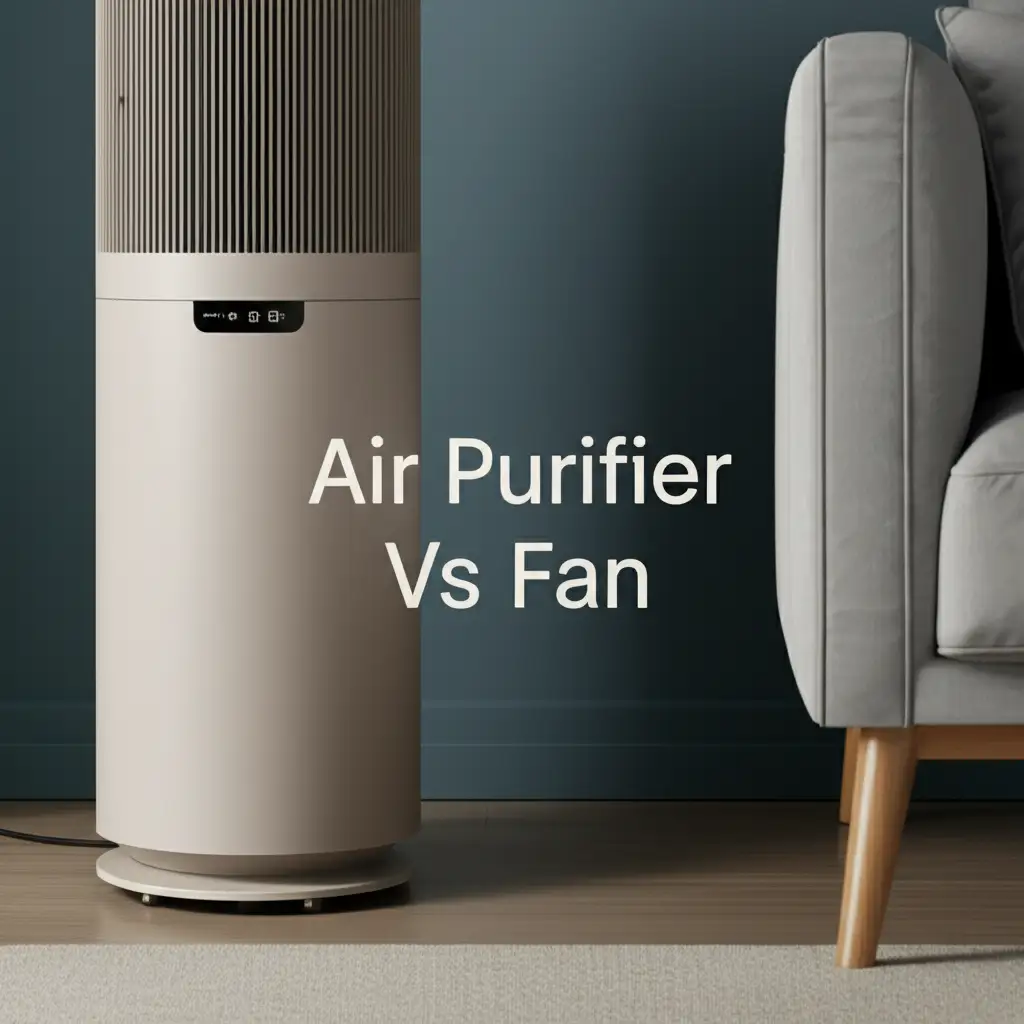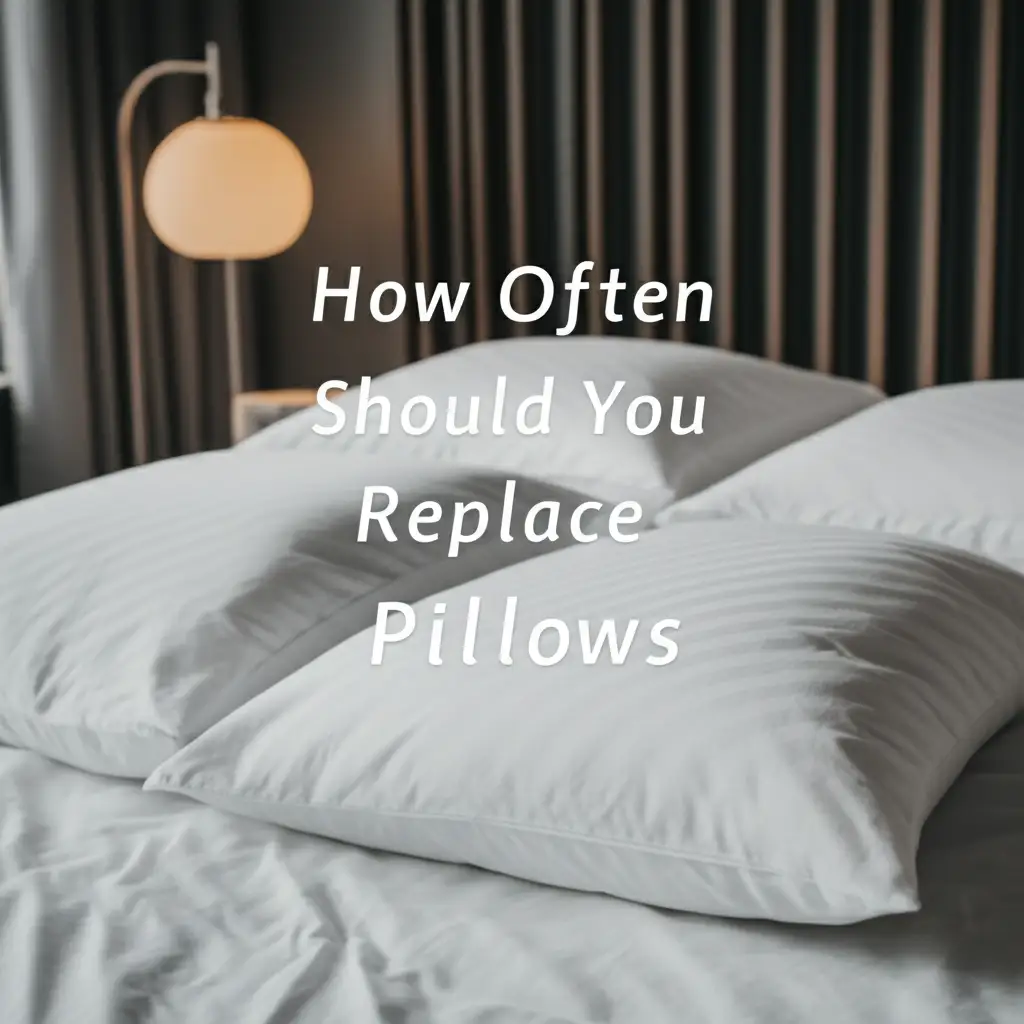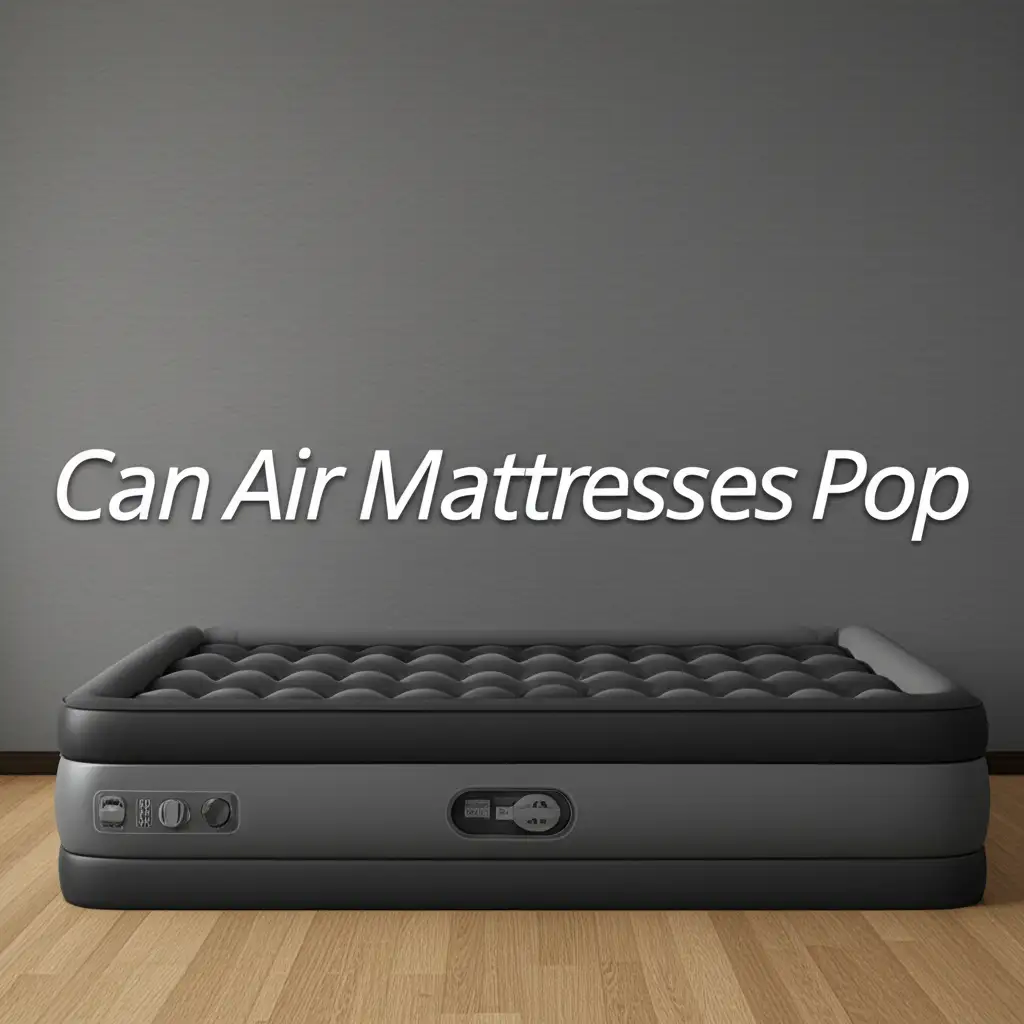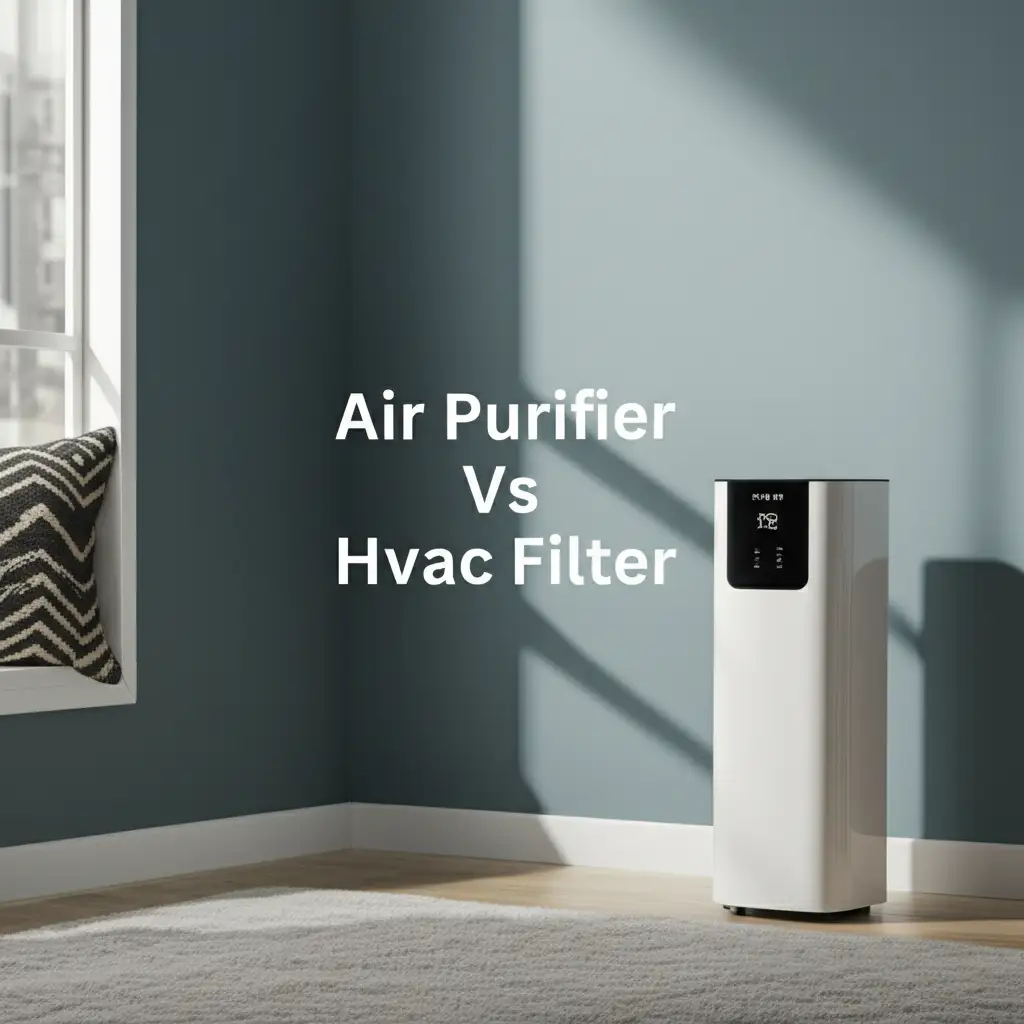· Elira Thomsen · Home Comfort · 17 min read
Air Purifier Vs Fan

Air Purifier Vs Fan: Which Helps Your Home More?
Stepping into your home, you want to feel comfortable and breathe easily. Many people think about air quality and temperature. You might wonder if an air purifier or a fan is better for your space. Both devices deal with air. However, they serve very different purposes.
This article explores the fundamental differences between an air purifier and a fan. We will look at how each device works. We will also discuss their benefits for your home environment. You will learn about their costs and maintenance. By the end, you can decide which machine, or perhaps both, fits your needs best. Let us discover the best way to improve your indoor air.
Takeaway
- Air purifiers clean the air by removing pollutants.
- Fans move air for cooling and circulation.
- Choose an air purifier for allergies, dust, or pet dander.
- Choose a fan for immediate cooling and airflow.
- Using both can offer the best indoor environment.
When considering an air purifier vs fan, remember their core functions differ significantly. An air purifier actively cleans indoor air by trapping harmful particles, while a fan simply circulates existing air to create a cooling effect. Your choice depends on whether you prioritize clean air for health or airflow for comfort.
Air Purifier Vs Fan: Understanding Their Core Functions
Many people confuse the roles of an air purifier and a fan. These two machines improve your home environment in unique ways. It is important to understand what each device truly does. This helps you choose the right one for your specific needs. Both devices deal with air. However, their primary goals are distinct.
An air purifier is a specialized appliance. It works to remove harmful substances from the air you breathe. These substances include allergens, dust, pet dander, mold spores, and even odors. The purifier pulls air in, filters it, and then releases cleaner air back into the room. Its main job is to improve the quality of your air.
A fan, on the other hand, is a simpler device. Its main purpose is to move air. A fan creates a breeze. This breeze helps cool you down by speeding up sweat evaporation from your skin. It also circulates air within a room. This can help reduce stuffiness. A fan does not clean the air. It only makes the existing air feel more comfortable.
So, while both machines affect the air around you, their core functions are not the same. An air purifier focuses on filtration and cleanliness. A fan focuses on movement and comfort. Knowing this difference is the first step to making an informed decision for your home. We often overlook the basic principles behind common home appliances. Taking time to understand them helps us use them effectively.
The Science of Clean Air: How Air Purifiers Work
An air purifier uses advanced technology to clean your indoor air. These devices are more than just simple machines. They employ specific methods to capture and remove pollutants. Understanding this process helps us appreciate their value.
Most air purifiers use a multi-stage filtration system. The first stage is usually a pre-filter. This filter captures larger particles like dust and pet hair. This helps extend the life of the other filters. Regular cleaning of this pre-filter is important for efficiency. For example, ensuring proper airflow in your home extends to keeping all parts of your ventilation system clear, just as you would clean air vents.
After the pre-filter, air moves to the main filter. This is often a High-Efficiency Particulate Air (HEPA) filter. A HEPA filter captures 99.97% of airborne particles. These particles are as small as 0.3 microns. This includes pollen, mold spores, dust mites, and pet dander. HEPA filters are crucial for allergy sufferers. They physically trap tiny particles.
Some air purifiers also include an activated carbon filter. This filter specializes in removing odors and volatile organic compounds (VOCs). VOCs come from cleaning products, paints, and furniture. The carbon filter absorbs these gases. This significantly improves air freshness. It makes your home smell cleaner.
Other purifiers might use additional technologies. These include UV-C light, which kills bacteria and viruses. Some use ionizers. Ionizers release charged ions. These ions attach to particles in the air, making them heavier. The heavier particles then fall out of the air or stick to surfaces. It is important to check the specific technology used in a purifier before buying. Different technologies target different pollutants.
Maintaining your air purifier is key. Filters need regular replacement. This ensures the device keeps cleaning the air effectively. Ignoring filter changes reduces the purifier’s performance. It can even allow pollutants to recirculate.
The Power of Air Movement: How Fans Provide Comfort
A fan works by creating airflow. It does not clean the air, but it makes a room feel cooler. This is different from how an air conditioner works. An air conditioner actually lowers the air temperature. A fan simply moves the air around. This movement provides a cooling sensation.
When a fan blows air across your skin, it helps evaporate sweat. Evaporation is a cooling process. This is why you feel cooler even if the room temperature remains the same. Fans are very effective for personal comfort. They can make a stuffy room feel much more pleasant. You might use a fan in a bedroom or office.
Fans come in many types. There are ceiling fans, desk fans, tower fans, and box fans. Each type serves a slightly different purpose. Ceiling fans circulate air throughout a whole room. Desk fans provide direct airflow to a person sitting nearby. Tower fans offer a slim design and oscillate to cover a wider area. Box fans are portable and good for general air movement.
Using fans can also help with ventilation. If you open a window and place a fan near it, you can push stale air out or pull fresh air in. This helps to reduce odors and improve overall air freshness. For proper home air quality, good ventilation is essential. Ensuring your home’s air systems are clear, such as knowing how to clean air vents, is part of maintaining effective airflow and removing stale air.
Fans use less electricity than air conditioners. This makes them a more energy-efficient option for cooling. They are also much cheaper to buy. They do not require filters or complex maintenance. You just need to keep the blades clean. This prevents dust buildup. A fan is a simple solution for feeling cooler and improving air circulation without changing the air quality itself.
Beyond Basic Airflow: Key Differences and Benefits
The fundamental difference between an air purifier and a fan lies in their function. One cleans, the other moves. This distinction leads to very different benefits for your home and health. Understanding these benefits helps you decide what you truly need.
An air purifier directly improves your respiratory health. It removes allergens like pollen and pet dander. This is a huge benefit for people with allergies or asthma. Reduced exposure to these triggers means fewer symptoms. Imagine breathing easier every day in your own home. Air purifiers also tackle dust, mold spores, and even smoke. They can eliminate unpleasant odors, such as cooking smells or pet odors, by capturing the tiny particles that cause them. This leads to a noticeably fresher indoor environment. When you prioritize clean air, you prioritize your health.
A fan provides immediate physical comfort. The cooling sensation from a fan is instant. It does not clean the air. Instead, it makes the existing air feel better. This is especially useful during hot weather. Fans can make a room feel several degrees cooler than it actually is. They also help distribute air evenly. This prevents hot spots and cold spots in a room. For example, a fan can push cool air from an air conditioner into a far corner. This improves the efficiency of your cooling system. A fan is about making you feel comfortable right now.
Consider the problems each device solves. If you suffer from seasonal allergies, an air purifier helps remove the airborne pollen entering your home. If your house feels stuffy or hot, a fan provides immediate relief by moving the air. An air purifier addresses the unseen threats in the air. A fan addresses the immediate sensation of heat or stagnant air. They are not interchangeable. Each has a specific job that it does well. When you maintain your home, you clean many areas. This includes tasks like cleaning air vents to ensure clear airflow.
Impact on Health and Well-being: What Each Offers
The choice between an air purifier and a fan heavily depends on what you want to achieve for your health and overall well-being. Each device offers distinct advantages. These advantages cater to different needs in your home. Let us explore what each machine specifically brings to your living space.
An air purifier focuses on improving your respiratory health. It filters out tiny particles that can irritate your lungs. These particles include dust, pollen, pet dander, and mold spores. If you have allergies, asthma, or other respiratory conditions, an air purifier can make a significant difference. I have found that breathing cleaner air reduces my allergy symptoms. It helps me sleep better at night. Purifiers also remove airborne viruses and bacteria, which is a major health benefit. They reduce household odors from cooking, pets, or smoke, making your home smell fresher. This contributes to a general sense of cleanliness and calm.
A fan primarily impacts your physical comfort through temperature regulation. While it does not clean the air, it makes you feel cooler by promoting sweat evaporation. This cooling effect is crucial during hot weather. It helps prevent heat exhaustion and makes sleeping more comfortable. A fan also circulates stagnant air. This reduces stuffiness and improves overall air movement. Good air circulation can make a room feel more invigorating. It prevents pockets of stale air from forming. The feeling of a gentle breeze can also be very relaxing. It helps create a more pleasant environment. Maintaining clear airflow in your home is important for comfort and health. This includes regular tasks like cleaning air vents to keep your air moving efficiently.
Neither device replaces the other. An air purifier will not cool you down on a hot day. A fan will not remove dust or allergens from the air. Your choice should align with your primary concern. If airborne irritants are an issue, choose a purifier. If you need immediate cooling and air circulation, choose a fan. Many people find the best solution involves using both devices. They create a healthy and comfortable living space together.
Cost and Maintenance: A Practical Comparison
When choosing between an air purifier and a fan, cost and maintenance are important factors. These devices have different price points and ongoing expenses. Understanding these practical aspects helps you make a budget-friendly decision. I always consider the long-term costs of any appliance.
The initial cost of an air purifier is generally higher than a fan. A basic desk fan might cost $20-$50. A good quality air purifier can range from $100 to several hundred dollars, depending on its size and features. Larger purifiers for bigger rooms cost more. High-end models with advanced filtration systems can be even more expensive. This upfront investment is for a machine that actively cleans your air.
Operating costs also differ. Fans are very energy-efficient. They use less electricity compared to other cooling appliances like air conditioners. Running a fan for hours typically adds only a few dollars to your monthly electricity bill. They have no consumable parts that need regular replacement. You just plug them in and turn them on.
Air purifiers have ongoing maintenance costs, mainly for filter replacement. HEPA filters and activated carbon filters need replacement every 6-12 months. The cost of replacement filters varies. It can range from $30 to $100 or more per set. Failing to replace filters reduces the purifier’s effectiveness. It can even lead to the device circulating dirty air. Some purifiers have washable pre-filters, which helps reduce costs. However, the main filters are consumables. You should factor these recurring costs into your budget. Maintaining good indoor air quality also includes ensuring your entire home ventilation system is clean, such as regularly checking and cleaning air vents for optimal performance.
Cleaning is simpler for fans. You just wipe down the blades and housing to remove dust. This prevents dust buildup and ensures smooth operation. Air purifiers require occasional cleaning of the exterior and pre-filters. Replacing the main filters is the primary maintenance task. So, while fans are cheaper upfront and to run, air purifiers offer significant health benefits for their higher cost and ongoing filter expenses. Your decision comes down to balancing initial investment and long-term costs with the specific benefits each offers.
Choosing Wisely: When to Opt for an Air Purifier or a Fan
Deciding between an air purifier and a fan depends on your primary needs and the specific conditions in your home. Both devices improve your living space. However, they do so in different ways. Consider your main concerns before making a choice.
Choose an air purifier if you prioritize health and air quality. If you or family members suffer from allergies, asthma, or other respiratory issues, an air purifier is a valuable investment. It removes triggers like pollen, dust mites, pet dander, and mold spores. This creates a healthier breathing environment. Air purifiers are also excellent for homes with pets, smokers, or persistent odors. They can eliminate airborne pollutants and improve the overall freshness of your indoor air. If you live in an urban area with high outdoor pollution, an air purifier can provide a clean air sanctuary indoors. This is crucial for long-term well-being.
Opt for a fan if your main goal is comfort and air circulation. Fans are perfect for hot climates or during warm seasons when you need immediate cooling. They create a breeze that helps you feel cooler through sweat evaporation. Fans are also great for improving air movement in stuffy rooms. They can distribute air from an open window or an air conditioner more effectively. If you want to save on energy bills compared to running an air conditioner, a fan is a much cheaper alternative for cooling. They are also portable and can be moved from room to room easily. For general comfort and breaking up stagnant air, a fan is the simple, cost-effective solution.
Your choice should align with the problem you want to solve. Do you need to clean the air you breathe, or do you need to feel cooler? Many homes can benefit from both. You might use an air purifier in the bedroom for better sleep and a fan in the living room for daytime comfort. Understanding the distinct roles helps you invest wisely in your home environment.
Combining Forces: The Synergy of Both for Optimal Home Comfort
While air purifiers and fans serve different purposes, they can work together effectively. Combining an air purifier with a fan can create an optimal indoor environment. This dual approach addresses both air quality and thermal comfort. It offers a comprehensive solution for your home.
When you use an air purifier, it cleans the air. It removes pollutants, allergens, and odors. A fan, placed strategically, can help circulate this newly purified air more efficiently throughout the room. This means the clean air reaches you faster. It also helps the air purifier work better. The fan pushes the air towards the purifier or helps distribute the filtered air away from it. This prevents purified air from stagnating in one area. Imagine a purifier cleaning the air near your bed. A small fan can help circulate that clean air throughout the entire sleeping area. This enhances the purifier’s reach.
Fans also provide a cooling effect that purifiers do not offer. Even if your air is perfectly clean, a hot, stuffy room is still uncomfortable. Using a fan alongside a purifier gives you both clean, fresh air and a comfortable temperature. This is especially beneficial in warmer months. You can breathe easily while also feeling cool. This synergy ensures you get the best of both worlds.
For example, I use an air purifier in my living room to manage pet dander and dust. On warm days, I turn on a tower fan. The fan circulates the clean, fresh air from the purifier. It also provides a cooling breeze. This makes my living space feel very pleasant. It is a noticeable difference compared to using just one device. Maintaining good air movement is key to a comfortable home, and regular checks on things like cleaning air vents can further improve this synergy, ensuring all systems work together efficiently.
This combined strategy is often the best choice for achieving true home comfort. You invest in clean air for health. You also invest in air movement for immediate physical comfort. The devices complement each other. They create a more enjoyable and healthier living space overall. It is about maximizing your indoor environment.
FAQ Section
Does a fan purify air?
No, a fan does not purify air. Its primary function is to move air. It circulates existing air to create a cooling effect through evaporation. It does not contain filters to remove dust, allergens, or pollutants from the air. A fan helps with air circulation, not air cleaning.
Can an air purifier cool a room?
An air purifier does not cool a room like an air conditioner or fan. It focuses on cleaning the air, not lowering its temperature. Some purifiers have a fan-like component to pull air in and push clean air out. This may create a slight breeze, but it will not reduce the room’s overall temperature.
How often should air purifier filters be changed?
Air purifier filters typically need changing every 6 to 12 months. This depends on the specific model and how often you use it. High-usage environments, like homes with pets or heavy pollution, may require more frequent changes. Always check your purifier’s manual for exact recommendations to ensure optimal performance.
Is an air purifier worth it for allergies?
Yes, an air purifier is highly worth it for allergies. It removes common airborne allergens like pollen, dust mites, pet dander, and mold spores. Reducing exposure to these triggers can significantly alleviate allergy symptoms. It helps create a safer and more comfortable indoor environment for allergy sufferers.
What is the best placement for an air purifier?
Place an air purifier in the room where you spend the most time, such as your bedroom or living room. Position it on a flat surface, away from walls or furniture that might block airflow. Keep it in an open area to allow for maximum air circulation and purification effectiveness.
Does proper home ventilation affect air quality?
Yes, proper home ventilation greatly affects air quality. It brings fresh outdoor air in and removes stale, polluted indoor air. Good ventilation helps reduce concentrations of indoor pollutants, odors, and moisture. This creates a healthier and more comfortable living environment. Regular maintenance, such as cleaning air vents, improves overall ventilation.
Conclusion
Choosing between an air purifier and a fan comes down to understanding their core missions. An air purifier actively cleans the air you breathe, removing harmful pollutants like allergens and dust. A fan, however, focuses on moving air, providing immediate cooling and improving circulation. Neither device replaces the other. They serve distinct and valuable purposes in your home.
Your best choice depends on your specific needs. If your priority is health, especially for those with allergies or respiratory issues, an air purifier is the clear winner. It creates a sanctuary of clean air. If comfort from heat and better air movement are what you seek, a fan offers an efficient and affordable solution. Often, the ideal scenario involves using both. An air purifier ensures clean air, while a fan helps distribute that clean air and provides welcome cooling.
I encourage you to evaluate your home’s air quality and comfort needs. Do you struggle with dust or pet dander? Is your home often stuffy or warm? Consider investing in the device that directly addresses your main concern. Or, embrace the synergy of both. Enhance your living space with both clean air and comfortable temperatures. Make your home a truly enjoyable place to be.





